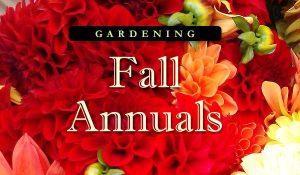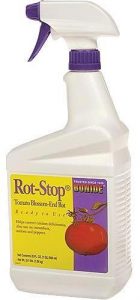by Ken Lain, the mountain gardener

Our part of the country is celebrated for its mild four-season climate, but gardeners new to the region often don’t realize just how nice it really is: Gardens can be coaxed into bloom most months of the year!
Strategic planting of early winter bloomers can keep flower color in the yard right into next  year. By the end of October the first frost arrives, taking out summer flowers and leaving the yard looking quite barren. That means there are only two months of blooming left for our gardens’ summer flowers. September is the month to plant hardy flowers that will bloom through November and December. Watters Garden Center has brought in the first crops of mums, dusty miller, fall marigolds, Johnny jump-ups, and pansies. These winter bloomers only get bigger and better as we progress through September.
year. By the end of October the first frost arrives, taking out summer flowers and leaving the yard looking quite barren. That means there are only two months of blooming left for our gardens’ summer flowers. September is the month to plant hardy flowers that will bloom through November and December. Watters Garden Center has brought in the first crops of mums, dusty miller, fall marigolds, Johnny jump-ups, and pansies. These winter bloomers only get bigger and better as we progress through September.
Any unhealthy plants that are struggling, out of bloom, bug prone, or are mildew-covered should be culled from the landscape ASAP, to make room for the flowering plants that will persevere well into next year. Some summer blooming plants still look so good in September that it can be difficult to pull ‘em and toss ‘em. However, the secret to early winter flowers is in planting early enough to take advantage of rains and the warm ground. Cold-hardy bloomers should be established before the soil cools in November. So buff up your inner courage and pull out those plants that have to go!
~ * ~
Ornamental grasses, thyme lawns, and fall flowers all love a good monsoonal rain. Gardeners do, too, as anyone working a garden knows that a shovel goes through soaked ground “like a knife though warm butter”. Well, maybe not quite like butter, but undoubtedly more easily than the holes dug during the crusty, dry months. Trust me on this; during this monsoon season many new plants have gone into the soft ground at the Lains’ casa. Rain definitely is a gardener’s best friend.
~ * ~
September is the month to harvest most mountain vegetables and herbs. Although summer rains have increased the harvest, increased rainfall brings the chance of blossom end rot. Watch fruits for black spots showing up where the blossom was. The slightest calcium deficiency causes this phenomenon, but it is easily corrected.
Combat this rotting, while encouraging more flavorful fruit, by spraying plant foliage with ‘Rot Stop’. This is the most effective form of liquid calcium, and it even prevents future fruit damage. Spray problem plants once a week through September to increase production, flavor, and rot-free fruits.
Baskets full of tomatoes are sitting on our kitchen counter waiting to be processed. If you are overwhelmed by the bounty from your garden, don’t forget that fresh fruits and vegetables are a blessing gratefully received at our local food banks and soup kitchens. Most fresh food donations are so few they are delivered and used the same day they are donated.
~ * ~
Garden Alert – Spittlebugs have landed and are sucking plants dry! White slimy globs ooze from the outer new growth of plants as this tiny brown bug drains the life out of our plants. Just run a hand through a plant’s foliage and if it comes out slimed, there is a problem. Not only is the slime ugly, it also is dangerous to plants. Locally, recent damage has been found on grapes, autumn sage, and Virginia creeper.
YouTube – This is a great time lapse video of spittle bugs in action.
Although any insecticide can kill spittlebugs, it’s difficult to get the bug killer through all that white slimy spittle. With some organic ‘Home Harvest’ spritzed onto each infected area, the bugs soon are eliminated. It is an insect eliminator that is safe for human consumption so it can be sprayed up to the day it is harvested, and is no threat to birds and pets. With the grape harvest so heavy this year, we need to be especially careful to select and apply the appropriate bug killers.
~ * ~
Only family and closest friends are allowed into my private gardens. This is because my gardens give me an escape from life’s pressures and guarantee some alone time. Fellow gardeners will concur that our gardens truly are our private sanctuaries. However, I don’t mind sharing my gardens through video.
All the recent new plantings that went into my gardens provided the perfect opportunity to shoot another local video. My latest YouTube production is “How to Plant for Local Success”, and it shares the steps needed for new plantings to thrive. The six-minute garden tutorial virtually guarantees successful landscaping. Check it out and if helpful, give it “a thumbs up” and share with family and friends who are interested in gardening.
~ * ~
Free Gardening Class – The season’s first fall garden class will be next Saturday at 9:30 a.m. in Watters’ back greenhouse. The topic is “Wildlife & Bug Prevention – What’s Eatin’ Your Garden?”. The fall schedule of classes is available at WattersGardenCenter.com.
Until next issue, I’ll see you at Watters Garden Center.
Ken Lain can be found throughout the week at Watters Garden Center, 1815 W. Iron Springs Rd in Prescott, or contacted through her web site at WattersGardenCenter.com or FB.com/WattersGardenCenter .

